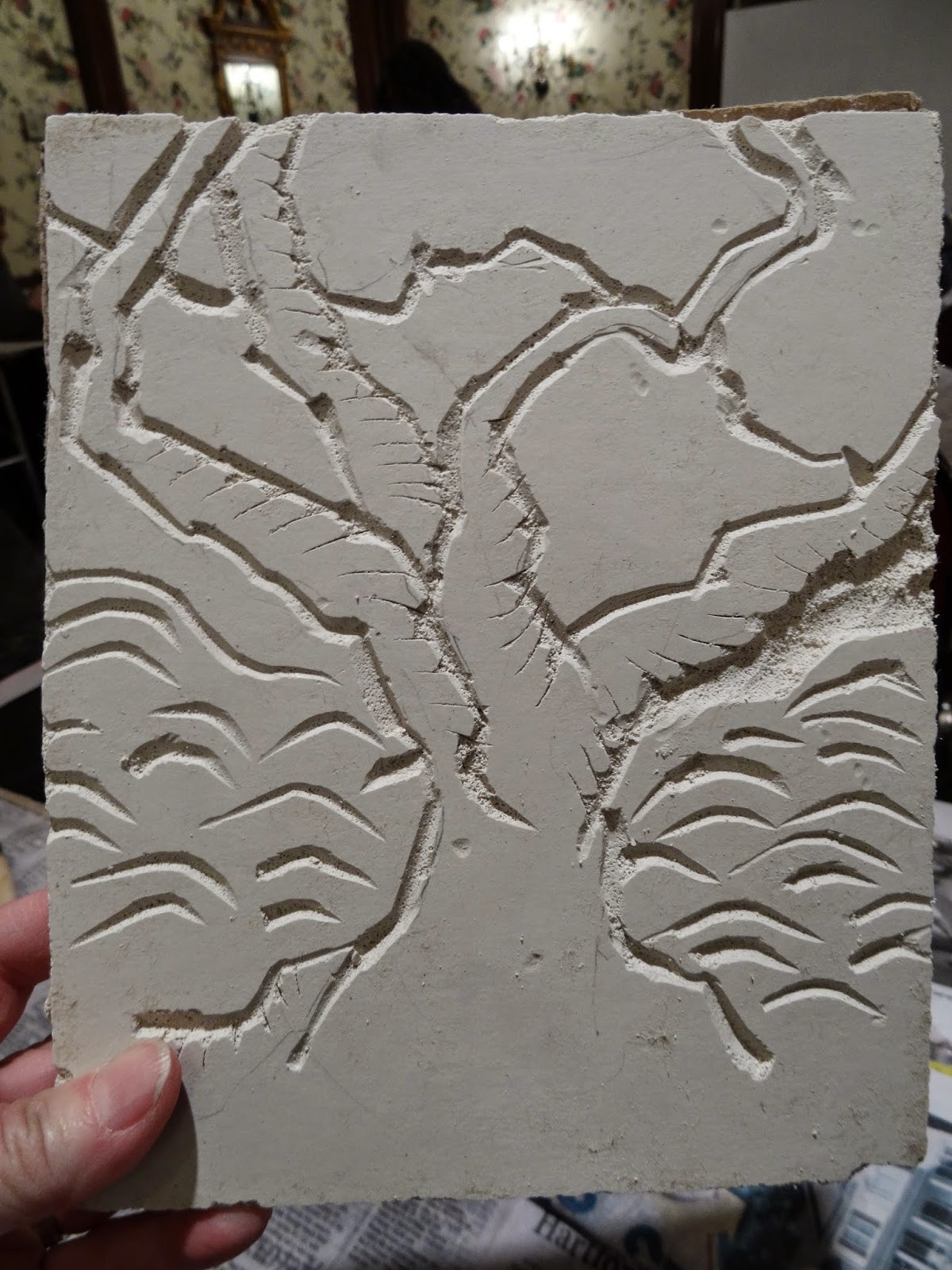The two masks at the top of the post, and the landscape and cartouche below are my personal examples, made for lessons done with my 6th grade students in past years. The two masks above were painted very differently from each other; the one on the left was done with acrylics and is covered with a coating of an acrylic gloss (it might be ModPodge; I'm not sure). The one on the right was painted with watercolors. It gives a very interesting and subtle effect, I think.
The landscapes were an assignment covering multiple topics: students learned about relief carving, they used perspective to create depth, and they explored working with limited color choice. The main painting was monochromatic, using values of one color of their choice. They were allowed to add a pop of the complementary color (in various values) in one or two places in their landscape. The piece shown above was painted with acrylics. It is a relief carving (as are all these pieces), though unfortunately it is hard to see the relief in the photo. The kids' work on this landscape project was lovely, their color choices were unique, and unfortunately I don't seem to have a single photo of the work. Nor do I have photos of the students' carved masks.
I do, however, have many photos of student cartouche carvings. You can see them in other posts on this blog, as I've actually posted about Sheetrock carving on this blog several times before. You can find all the other posts (including one written after a workshop a year ago, and ones with student work from prior years) by following this link. Meanwhile, here is a sample of student cartouche carvings.
In the workshop, we began by removing the paper surface from the Sheetrock, leaving on the cardboard backing. To remove the paper, wet the surface with a sponge, let it soak in for a minute, and begin peeling. Repeat. You can use your thumbs, or you can use an artgum eraser to help remove the paper.
Once the surface paper is removed, you are ready to carve. Students can draw their plans and trace them onto the Sheetrock (once it is dry) with carbon paper, or draw directly with pencil. Since we did all our work in one evening, participants drew quickly with pencils or proceeded with no pre-drawing at all.
The workshop participants had some pretty creative ideas! There was the hammerhead dog (above) and also a mermaid bunny, which you will see pictured later in the post. What do we use for carving tools? Preferred tools include a variety of sizes of U and V gouges (we've used both woodcarving tools and old linoleum cutters), sharp liner tools or some other pointy tool, and also heavy duty loop tools. Because you work with the surface moistened, the tools don't slip as easily as on linoleum, meaning it really is rare that someone gets hurt with a cutting tool.
On Facebook, people expressed concern about dust. This is NOT an issue. We keep the surface of the Sheetrock moist when carving, so no dust is produced. Yes, it is messy; NO, it is not dusty!!
Sometimes, the material may crack or break in unintended places. You can either attempt a repair (mix up a small batch of plaster to patch), or glue any cracks when done. My students liked the glued cracks, because it helped make their pieces look ancient. Sometimes, though, an unintended break may necessitate a design adjustment, as in the mouth (above and below). The artist was quite happy with her solution! Me too; I like the open mouth much better.
When carving was done, workshop participants had a variety of paints to experiment with. The tree below was painted with acrylic.
While this flower was painted with watercolor. I think both pieces are lovely!
Yes, it's the mermaid bunny! (below, painted with watercolor)
Other techniques we experimented with included painting the peeled surface with a coating of India ink prior to carving, and then carving into it, exposing the white gypsum. I don't have a photo of the finished piece, but once the carving is done, the exposed white gypsum can then be painted with watercolor, and the whole thing can be sealed with an acrylic gloss if desired. One last thing - if you do embark on carving Sheetrock, make sure it does NOT have fiberglass or some such filament in it, or it will feel like little needles poking into your hands. All you have to do is hold up the Sheetrock and look at the edges. You will see tiny clear/white hairlike pieces sticking out from the edge. Look carefully; they are small and almost colorless, but nasty!! I purchased my Sheetrock at Lowe's in smaller more manageable sheets than the wall-size (maybe 36" square?), and while it was a little more costly to buy that way, it still is a very inexpensive item.


















































